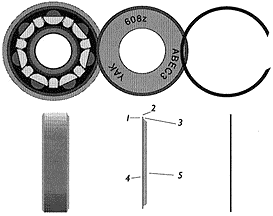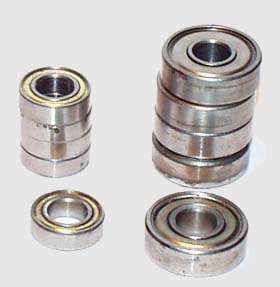Skate bearings: ABEC and ISO standards… Same difference?
Here are two barbarous acronyms which sometimes conceal very different realities. Even if the A.B.E.C. standard is the most common on the market and is often favored by vendors, yet it is not systematically a token of quality…
Par alfathor

Article issued in 2004 and updated in 2012
The ABEC Standard
 ABEC means: Annular Bearing Engineer Council. It is an American manufacturing tolerance rate. An ABEC 1 bearing will allow a bigger play than an ABEC 3 or ABEC 5 bearing for example. It is thus less precise. That standard is about the perfection or imperfection of the sphere of your bearing’s balls.
ABEC means: Annular Bearing Engineer Council. It is an American manufacturing tolerance rate. An ABEC 1 bearing will allow a bigger play than an ABEC 3 or ABEC 5 bearing for example. It is thus less precise. That standard is about the perfection or imperfection of the sphere of your bearing’s balls.
When the bearings are manufactured, their balls are filtered according to their precision and will be of this or that type of use.
To sum up, ABEC 1 bearing balls are less round than ABEC 5 balls.
The limits of the ABEC standard
However, the ABEC standard does not specify the quality of the used material. A manufacturer may make bearings with clay or resin and apply the ABEC 7 norm without being investigated. What makes the quality of a bearing is above all the quality of its material. The reference alloy is a 100cr6 chrome steel quoted on the stock-exchange, which remains a token of quality.
For a long time, the use of the ABEC standard resulted from a strategical choice made by Asian factories who would not always master the ISO standard. In doing so, they forced all the world manufacturers to conform in order to allow a better comparison between the products, whereas they used the ISO standard which is far more draconian.
The ISO standard will offer more quality guarantee on the manufacturing process.
What is the ISO standard?
The ISO standard is a certification given to the brands by a specialized organization which evaluates the manufacturing processes and the products. the ISO is a standardization network of 146 national institutes. The aim of that nongovernmental organization, which follows the principle of one member per country, is to help, standardize and guarantee a conformity of industrial products.
Is there a link between the two standards?
 A.B.E.C. and ISO standards:
A.B.E.C. and ISO standards:
ABEC 1 = ISO 0
ABEC 3 = ISO 6
ABEC 5 = ISO 5
ABEC 7 = ISO 4
ABEC 9 = ISO 2
The manufacturers are not dumb, doing without the ABEC standard, so comfortably settled in the public mind, would make them lose market shares. They often indicate both standards, then. If no standard appears on the bearings, move on! Moreover, for a dozen years, the ILQ has been more and more talked about…
As for ILQ, what does it mean?
Twincam is the manufacturer probably selling the most bearings in the skating world. Founded in 1986, the brand started producing bearings specific to skating in 1990. In 2012, Twincam launched the commercial brand « ILQ ». It is not a standard but a commercial brand. The principle: a 6-ball bearing corresponds better to a skating use.
As a conclusion
The ABEC is not a token of quality, that obsolete standard rates the spherical perfection of the ball from worst to best: ABEC: 1, 3, 5, 7, 9… without worrying about the manufacturing processes and the used material. A bearing that is ISO certified guarantees at least a good manufacturing quality. As for the ILQ, it is above all a commercial brand, a marketing concept rather than a real token of quality.
Useful links
How to clean and take care of your bearings?
How to extract bearings from wheels?
Test: Twincam ILQ-X MR2 Bearings
Translation: Chloé Seyres
Photos: Alfathor, all rights reserved
